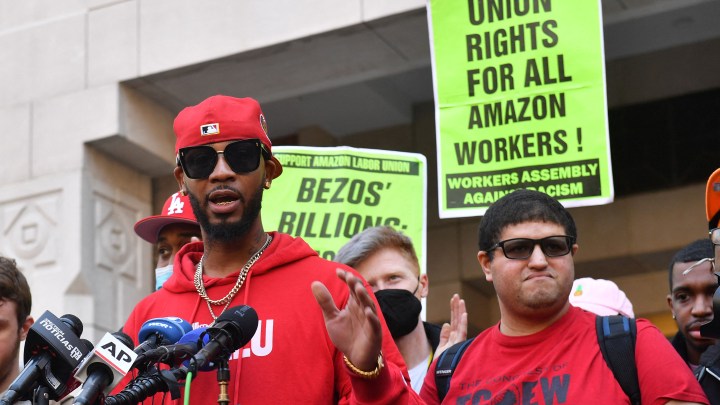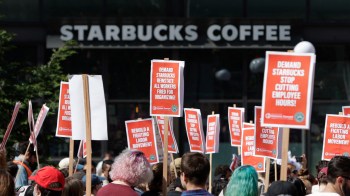
New film follows Amazon union efforts, challenges for labor ahead
New film follows Amazon union efforts, challenges for labor ahead

This month’s selection for Marketplace’s “Econ Extra Credit” project is “Union,” a new documentary that follows the first successful campaign to unionize workers at Amazon in the U.S. This was the grassroots union effort a few years ago at an Amazon fulfillment center in Staten Island, New York, known as JFK8.
The contents of the film highlight a historic labor struggle, which is still ongoing even two and a half years since these fulfillment center workers voted to unionize. But the circumstances surrounding the film’s creation also provide an important economic lesson, one that pertains to the entertainment industry. Despite festival selections and critical acclaim, the film has not gotten any major distributor onboard, and it’s currently being self-distributed.
Stephen Maing is one of the film’s directors, along with Brett Story, and he spoke with “Marketplace Morning Report” host David Brancaccio about this. The following is an edited transcript of their conversation.
David Brancaccio: The reviews have been strong for the film. You and your team are distributing it yourselves. No one bought the rights. What do you think is going on here?
Stephen Maing: We live in a moment when the most powerful corporate leaders in the world can purchase an entire newspaper and squash a presidential endorsement when it feels like it threatens their profit strategy. So, similarly, we have felt the financial forces upon our distribution efforts. We were, like, one of 10 or 15 U.S. documentaries chosen from a pool of 12,000 submissions to Sundance. We got an award, invited to 100 or so festivals, and yet we’ve been sidelined in the distribution process, like so many other fantastic films, like “No Other Land” and “Sabbath Queen” and “The Battle For Laikipia,” “Homegrown” — the list goes on, “Porcelain War.” There are so many films out there that are struggling, like ours, to find distributions. But, also, we’re being told by friends working with distributors and studios that they’re so sorry, because they love the film and find it so urgent, but, “We do a lot of business with Amazon,” or, “The labor conversation in the film raises a lot of uneasy questions for our bosses.”
Brancaccio: But it’s about connecting with groups across the country to essentially embrace the film and get it in front of people.
Maing: I mean, absolutely. This film is all about building community, right? The thing that was so astounding to watch the Amazon Labor Union do in Staten Island at their fulfillment facility was to build a community of care and love from scratch. They were building an organization that never existed in the beginning. It just started with asking their coworkers, “How are you doing?” And hearing their grievances or their hardship, the things that were happening in this workplace that has very pre-designed termination practices. There’s a 150% turnover rate for workers at Amazon. So imagine, every six months, the entire workforce being fired, quitting, being injured, leaving for one reason or another, and wholesale replaced. So what this group of workers did that was astounding, was they not only convinced more than 50% of their 8,300-worker warehouse to vote in favor of the union, but they did that with incredible attrition rates, by reaching people and just basically extending a concern and a care and an interest in how they were doing.
Brancaccio: Another way to look at this, Steve, is that if Amazon were so bad, they wouldn’t be able to keep getting people to replace the people who leave by attrition. The numbers seem to show that people are attracted to working at Amazon for many reasons.
Maing: Like in many sectors of society right now, what we’re looking at is a battle of competing narratives, right? This is a company, a powerful company, that invests millions of dollars into the propaganda of wanting the public to believe and see them as “Earth’s best employer,” right? This is their words, not mine. And so with that comes this idea that you come to work for Amazon, you can build a career. You use this as a stepping stone, though. You don’t need to stay here for very long, because you have bigger and better things out there waiting for you. And yet, here’s a company that has invested tremendously into a kind of business practice that doesn’t just affect Amazon workers. It is helping define the future and present of work for workers today as we know it. And so I think this idea that what is visible of a company like Amazon — and this film, is not just about Amazon, right? This is very much about all corporations. But, when you look at a business like Amazon, you have to understand that these are workers that they have preyed upon, right? Everybody wants things cheap and fast, and where does that burden fall? On the workers. This group of the working class that have been deemed invisible for decades. On top of that, they’ve actually been discouraged in the past. For decades, Amazon and the workers at Amazon were told, “Well, this is a space that is unorganizable. Amazon cannot be beat, so don’t even bother trying.”
And so I think what’s fascinating when you think about that is, here is a new community of workers who have set out to prove otherwise, knowing that win or lose, they need to at least try. Because they need to attempt to be the catalyst of change that they haven’t seen. What was notable about this group of workers is that they represent this group that, when you think back to 1935, when [President Franklin Delano Roosevelt] brought about New Deal reforms, one of the amazing coups was this actuality of the National Labor Relations Act. So that, for the first time, workers were allowed to collectively bargain or strike, but meet their employers at the negotiating table. So, this sounds great, except, conspicuously missing from that was domestic workers, were agricultural workers. And who were they? They were minority workers, immigrant workers. They were women. And so when you fast forward almost 100 years later, this is the exact group of grassroots workers-turned-organizers who have now set out to reclaim their voice and their place in the labor movement. For us, it was an incredible privilege to be on the ground and bear witness for over three years as they actually set out to gather a little over $100,000 in crowdfunding to beat an over $14 million anti-unionization campaign, and do that victoriously.
Brancaccio: Yeah, because we should point out that the organization that was done at that warehouse in Staten Island, New York, was not done under the auspices of a larger organization, even though the union now is allied with the Teamsters.
Maing: That’s right, and it’s not to say that the Teamsters or [United Food and Commercial Workers] or others were not there, lending some support. They were, but it was not the kind of level of support that these very powerful, established unions could have invested. And, if I’m being honest with you, we were there and we watched, and there was hedging. I think there was this sense that, like nobody really, totally believed they could pull it off. And when it comes to the media and the public at large, there was also this sense that there were other really more interesting and exciting unions. Starbucks, Trader Joe’s, REI — there were so many other organizing efforts that got the lion’s share of media attention, until they won. And so that’s really notable, that there was then a kind of wellspring of interest where there hadn’t been as much previously.
Brancaccio: A complex story, though, at many levels, which you evoke in the film, but another piece of the complexity is that, OK, they have the union. But are they now negotiating on a contract with Amazon?
Maing: This is the really staggering part, that it’s been 30 months since they beat Amazon, and there has been no bargaining order. Amazon has refused to come to the negotiating table, and yet this is actually not surprising at all. I mean, we’ve heard stories in this country of it taking two, three, five, even seven years for a contract to be negotiated after an election victory. And so we have to really think about, as we move forward, we have a lot of political challenges ahead of us, but how do we actually look at labor law and the role of the [National Labor Relations Board] to protect unionizing efforts, and especially when it’s in a place where workers have proved that they deserve a contract.
Brancaccio: Did you see, just the other day, the National Labor Relations Board came out with a new rule that going forward, companies can no longer make blanket statements that potentially joining a union is going to be bad for you or your career? And in your film, you see some of the education that Amazon is doing to that effect, a couple years ago.
Maing: This is a major victory for the labor movement. And the role of “captive audience” meetings in these union-busting efforts has been incredibly troubling. And so we have to ask now, you know, how long is this going to last? We have an [incoming] administration that has been very open when you look at the kind of like mission of Project 2025. And the administration, there’s a lot of antipathy for some very basic and very vital achievements that the labor movement has created. We’re going to see a weakening of collective bargaining and negotiations. We’re going to see a weakening of even like child labor law. The idea of worker protections around race and ethnicity, a lot of things are going to be hanging in the balance in the years to come.
Brancaccio: So a big push for the film starting Black Friday, the big shopping time. I guess that’s not a coincidence, right? You guys are up to something?
Maing: Yeah, that’s right. Look, I mean, we are so grateful to be able to offer this film independently in a nationwide release to any Amazon worker who wants to see it. You let us know, and we will be glad to share it within your capacity and means. And we want to make sure that people understand that it’s also like a really thrilling and cinematically made film. We believe that cinema has a great propensity to reveal power imbalance and address political and social structures, but also move you and take you on a journey with people that you might not otherwise ever had the chance to meet and to watch undertake something so thrilling and exciting. Like I, personally, have always loved stories of unlikely heroes in their own journey, people who become the protagonists in their own dilemmas and find ways to empower themselves. And so this is a perfect example of that, where these workers, most of them had never organized a day in their lives before, and became part of a revitalization of the labor movement.
We reached out to Amazon for comment. The company did not respond to our request by deadline.
There’s a lot happening in the world. Through it all, Marketplace is here for you.
You rely on Marketplace to break down the world’s events and tell you how it affects you in a fact-based, approachable way. We rely on your financial support to keep making that possible.
Your donation today powers the independent journalism that you rely on. For just $5/month, you can help sustain Marketplace so we can keep reporting on the things that matter to you.

















